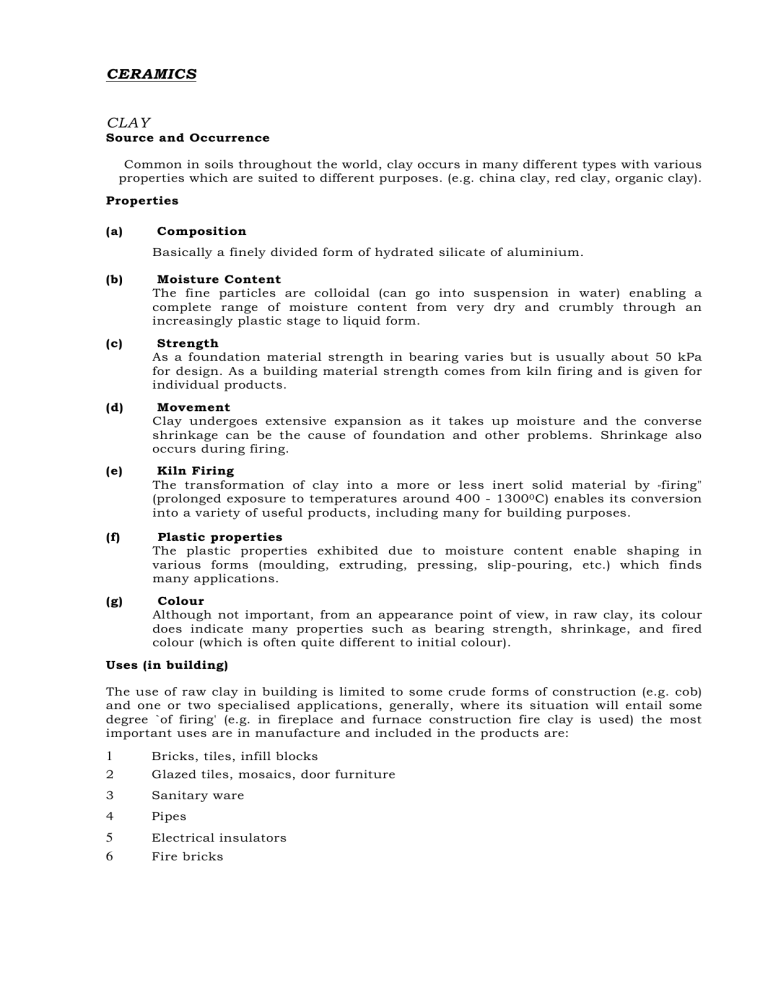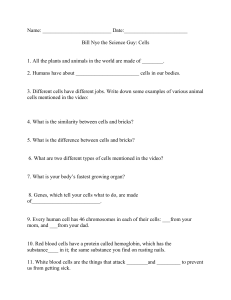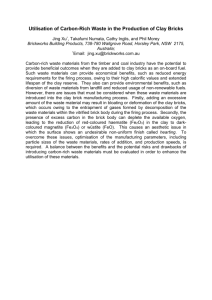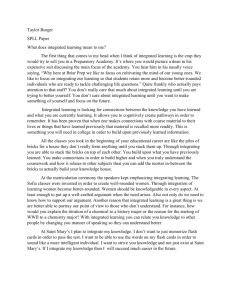Ceramics & Clay: Properties, Uses in Building | Technical Guide
advertisement

CERAMICS
CLAY
Source and Occurrence
Common in soils throughout the world, clay occurs in many different types with various
properties which are suited to different purposes. (e.g. china clay, red clay, organic clay).
Properties
(a)
Composition
Basically a finely divided form of hydrated silicate of aluminium.
(b)
Moisture Content
The fine particles are colloidal (can go into suspension in water) enabling a
complete range of moisture content from very dry and crumbly through an
increasingly plastic stage to liquid form.
(c)
Strength
As a foundation material strength in bearing varies but is usually about 50 kPa
for design. As a building material strength comes from kiln firing and is given for
individual products.
(d)
Movement
Clay undergoes extensive expansion as it takes up moisture and the converse
shrinkage can be the cause of foundation and other problems. Shrinkage also
occurs during firing.
(e)
Kiln Firing
The transformation of clay into a more or less inert solid material by „firing"
(prolonged exposure to temperatures around 400 - 1300 0 C) enables its conversion
into a variety of useful products, including many for building purposes.
(f)
Plastic properties
The plastic properties exhibited due to moisture content enable shaping in
various forms (moulding, extruding, pressing, slip-pouring, etc.) which finds
many applications.
(g)
Colour
Although not important, from an appearance point of view, in raw clay, its colour
does indicate many properties such as bearing strength, shrinkage, and fired
colour (which is often quite different to initial colour).
Uses (in building)
The use of raw clay in building is limited to some crude forms of construction (e.g. cob)
and one or two specialised applications, generally, where its situation will entail some
degree `of firing' (e.g. in fireplace and furnace construction fire clay is used) the most
important uses are in manufacture and included in the products are:
1
Bricks, tiles, infill blocks
2
Glazed tiles, mosaics, door furniture
3
Sanitary ware
4
Pipes
5
6
Electrical insulators
Fire bricks
Uses
Although occasionally used as fill, spacers and so on, bricks are almost invariably used as
repetitive pieces arranged together to form a wall, floor or similar except in the
construction of some paving and furnaces, bricks are bonded together by mortar and the
manner in which they are arranged together is called the 'bond'. There are various
standard sorts of bond - stretcher, stack, Flemish, English, and so on - the principle being
to avoid one perpend (vertical joint) occurring directly over another unless the wall
strength is of no consequence (e.g., stack bonding).
http://en.wikipedia.org/wiki/File:Billbeee-flemishb.png
Flemish bond
http://plato.acadiau.ca/courses/educ/reid/geometry/brick/Mvc006s.jpg
http://en.wikipedia.org/wiki/File:Billbeee-eng-bond.PNG
English bond
http://plato.acadiau.ca/courses/educ/reid/geometry/brick/Stack_B
ond.jpg
Stretcher/Running bond
Stack bond
Brick walls vary from single skin brick 'veneer' secured with metal ties to studwork(typical
in New Zealand), to cavity wall construction and thick solid wall construction of some of
the `bonds' mentioned above. Bricks can be used in structural applications in conjunction
with reinforcing steel if needed, and a particular consideration is their behaviour under
earthquake.
Techniques
As a result of some brick properties, the following should be observed:
(a)
Bricks are best laid 'wetted' as dry bricks suck moisture from the mortar.
(b)
Where there could be a problem of 'rising damp' in brickwork a damproof course is
used either in a low joint or by laying a course of impervious bricks.
(c)
Although suitable for many types of decoration, ample drying time should be
allowed for bricks.
(d)
Because of dimensional variation, bricks are normally laid with a 'face side' and a
'backside' and in single-skin work this can be limiting.
Associated materials
A range of related products are made including tiles, 'pavers' and the like, and 'specials'
(such as 'bull noses') are available for some lines.
Mortars
Plaster/render
Bonding strip - expanded or deformed galvanised steel laid in joints where
continuity is especially important.
Ties galvanised or stainless steel purpose-made to secure brickwork
across cavities
Grounds -
DIPMAT98 PAS.
wooden (usually) blocks set in joints to allow fixing of other items
(e.g., door frames)
Properties
(For single bricks, properties of walls may differ).
1) Strength:
a) Compressive; Overseas 'engineering bricks' can reach compressive strengths as
high as 50 MPa but ordinary bricks in New Zealand are usually in the vicinity of
1/3 of this. 'Safe bearing loads' for brickwork vary with wall construction but will be
in the region of 500 KPa.
b) Tensile; Bricks have very low tensile strength.
2) Appearance: Consult makers' information for available varieties. Bricks vary in size,
proportion, colour, texture and consistency of colour ('Multicolour') Brickwork
appearance will also be affected by 'bonding and joint colour'. Bricks of the same
make, brand and colour will vary slightly from one manufacturing run to another.
3) Chemical resistance: Generally of good resistance to chemical attack, bricks
generally react badly to calcium sulphate which can occur in limestone areas or from
air pollution. Mortar is not always so tolerant. Special bricks should be used where
calcium sulphate occurs.
4)
Moisture content: Bricks will generally absorb significant quantities of water and
cannot be considered 'waterproof. Frost damage can occur where saturated bricks
become frozen.
5)
Porosity: Bricks and concrete Masonry are both porous materials.
6) Dissolved salts: Both bricks and mortar may contain salts which when subjected to
water (water-bourne) will travel to the surface of the wall (vertical or horizontal) and
accumulate on the surface as white 'effervescence' as the water evaporates. Although
clay and mortar can be prepared to prevent this it should not persist unless a poor
damp proof course allows soil salts to travel up brickwork.
7) Thermal movement: Although small (.000006°C), this may be important where
bricks are subject to extremes of heat, as small movements can initiate joint failure.
8) Insulator: Clay fired as ceramics make very good electrical insulators.
9)
Fire resistance: Very good by virtue of kiln firing
10) Sound transmission: Low by virtue of mass
11) Dimensional accuracy: Bricks, are allowed a manufacturing tolerance of -+-2mm
which is normally absorbed by varying joint thickness. This is significant however,
where cavity construction is critical or in some 'end' conditions such as piers, openings
etc.
12) Flexibility: Ceramics have very little flexibility.
13) Abrasion and Impact Resistance: Most bricks are fairly resistant to abrasion but
can suffer impact damage readily.
14) Sizes: Vary: length 219 - 295; height 50 - I l l , width 71 - 111
Effects of Firing
As well as causing some shrinkage, which may affect the accuracy of products and their
size, firing of clay will determine colour (due to change in clay and impurities due to
method of heating) strength, imperviousness to water a high firing temperature can cause
vetrification), and usually creates an electrical insulator. The slowness of temperature
change and ultimate temperature are principal factors in determining final properties.
Finishes
Clay, once fired, is either 'glazed' or 'unglazed' both, but especially the former, allowing for
a range of colours, patterns etc. Texture, pattern, etc., can be moulded into the raw clay
and can remain once fired.
Sanitary ware
As well as wash hand basins, WCs and so on common in domestic and commercial usage
many other fittings are made, including baths, tubs, urinals, bidets, sinks and some
special fittings (e.g. for medical use). Most of these must be imported and NZ’s use of
stainless and pressed steel largely replaces the more common ones.
Pipes
Glazed earthenware is no longer used for foul water drainage, except for some special
corrosive chemical work. Unglazed field tile drains are still manufactured for use in rural
ground water drainage applications
GIazed tiles. mosaics. door furniture
These tiles are available in many sizes (e.g., 25 x 25, 25 x 50, 50 x 50, 100 x 100, 150 x
150, 150 x 75 etc.), colours, finishes, (texture, pattern, etc.) and quantities. Smaller tiles,
known as mosaics now come on a gauze backing which greatly speeds laying, Tiles are
supplied from sources all over the world and thus delivery time must be confirmed before
commitment to a particular tile. Quantities vary enormously and selection is best made
from samples, some of which should be retained for reference during the work. When
choosing; check strength, scratch and chip resistance, water (and stain) penetration from
edges and fullness of glaze cover. Also consider suitability for purpose with regard to
cleaning of textured tiles, cleaning and erosion of joints, vandalism, replacement, etc.
The local authority's health inspector should be consulted where hygiene is involved. A
limited range of ceramic door furniture is available from suppliers such as Ceramco.
Consult a responsible hardware supplier for availability and suitability.
Floor Tiles
As well as brick-type tiles (quarries, pavers etc.) a large variety of ceramic floor tiles is
available, made generally of high strength dense ceramic material, often made for
particular purposes - such as abrasion resistance, non-skid, chemical resistance and the
like. Both local and overseas makes are available and should be sought through an
outlet specialising in tiles (some hardware and glass suppliers, tile centre etc.).
Insulators
A range is available but should only he specified on expert advice.
Bricks (Clay - Including quarry tiles and pavers )
Bricks are produced by firing clay, with certain other ingredients, and several varieties
are available. Although small scale manufacture is possible most New Zealand bricks
are made by Brick Makers (Monier)




